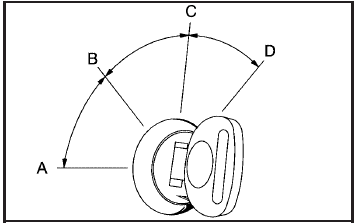Ignition Positions

Use the key to turn the ignition switch to four different positions.
A (LOCK): This position locks the ignition and transmission. It is a theft-deterrent feature. You will only be able to remove the key when the ignition is turned to LOCK.
Notice: If your key seems stuck in LOCK and you cannot turn it, be sure you are using the correct key; if so, is it all the way in? Turn the key only with your hand. Using a tool to force it could break the key or the ignition switch. If none of these works, then your vehicle needs service.
B (ACCESSORY): This position lets you use things like the radio and the windshield wipers when the engine is off.
Lengthy operation of features such as the radio in the accessory ignition position may drain the battery and prevent your vehicle from starting.
Do not operate your vehicle in the accessory ignition position for a long period of time.
C (RUN): This is the position for driving.
The battery could be drained if you leave the key in the ACCESSORY or RUN position with the engine off. You may not be able to start your vehicle if the battery is allowed to drain for an extended period of time.
D (START): This position starts the engine.
Key In the Ignition
Never leave your vehicle with the keys inside, as it is an easy target for joy riders or thieves. If you leave the key in the ignition and park your vehicle, a chime will sound, when you open the driver’s door. Always remember to remove your key from the ignition and take it with you. This will lock your ignition and transmission. Also, always remember to lock the doors.
The battery could be drained if you leave the key in the ignition while your vehicle is parked.
You may not be able to start your vehicle after it has been parked for an extended period of time.
See also:
Other Rainy Weather Tips
Besides slowing down, other wet weather driving tips include:
Allow extra following distance.
Pass with caution.
Keep windshield wiping equipment in good shape.
Keep the windshield washer fl ...
Using this Manual
To quickly locate information about the vehicle, use the Index in the back of the manual. It is an alphabetical list of what is in the manual and the page number where it can be found. ...
Parking Brake
The vehicle has an Electric Parking Brake (EPB). The switch for the EPB is in
the center console. The EPB can always be activated, even if the ignition is off.
To avoid draining the battery, do ...


